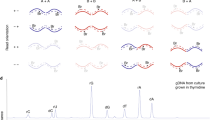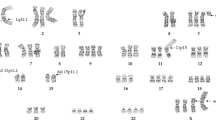Abstract
THERE is still controversy over the nature of sister chromatid exchanges detectable by autoradiography. Based on the relation between the number of exchanges and dose of tritium incorporated into DNA, Gibson and Prescott1 have concluded that all exchanges are radiation-induced and that none occurs spontaneously. But such an approach has an apparent technical drawback in that the declining of sensitivity of emulsion to tritium as well as latent image fading during long autoradiographic exposure provides a definite lower limit in the number of grains formed at a given tritium dose, and hampers greatly the detection of exchanges at very low dose of incorporated tritium. Another difficulty may arise from the fact that the exchange frequency reaches a saturation level at a very low dose and within a very narrow dose range, so that it is difficult to determine whether a dose response curve rises linearly with or as the square of dose. Extrapolation of the curve through the zero point can be misleading. To detect sister chromatid exchanges, I have, following the original work of Latt3, used a new method involving labelling of chromosomes with BUdR followed by acridine orange fluorescence staining, and have obtained results that suggest strongly the existence of spontaneous sister chromatid exchanges.
This is a preview of subscription content, access via your institution
Access options
Subscribe to this journal
Receive 51 print issues and online access
$199.00 per year
only $3.90 per issue
Buy this article
- Purchase on Springer Link
- Instant access to full article PDF
Prices may be subject to local taxes which are calculated during checkout
Similar content being viewed by others
References
Gibson, D. A., and Prescott, D. M., Expl Cell Res., 74, 397–402 (1972).
Kato, H., Expl Cell Res., 82, 383–390 (1973); Expl Cell Res., 83, 55–62 (1974); Nature, 249, 552 (1974); Expl Cell Res. (in the press).
Latt, S. A., Proc. natn. Acad. Sci. U.S.A., 70, 3395–3399 (1973).
Simon, E. H., Expl Cell Res., Suppl. 9, 263–269 (1963).
Witkin, E. M., A. Rev. Genet., 3, 525–552 (1969).
Lindahl, T., and Nyberg, B., Biochemistry, 11, 3610–3618 (1972).
Verly, W. G., Paquette, Y., and Thibodeau, L., Nature new Biol., 244, 67–69 (1973).
Djordjevic, B., Evans, R. G., Perez, A. G., and Weill, M. K., Nature, 224, 803–804 (1969).
Pietrzykowska, I., Mutation Res., 19, 1–9 (1973).
Author information
Authors and Affiliations
Rights and permissions
About this article
Cite this article
KATO, H. Spontaneous sister chromatid exchanges detected by a BUdR-labelling method. Nature 251, 70–72 (1974). https://doi.org/10.1038/251070a0
Received:
Issue Date:
DOI: https://doi.org/10.1038/251070a0
This article is cited by
-
Super-resolution visualization and modeling of human chromosomal regions reveals cohesin-dependent loop structures
Genome Biology (2021)
-
BAIT: Organizing genomes and mapping rearrangements in single cells
Genome Medicine (2013)
-
DNA template strand sequencing of single-cells maps genomic rearrangements at high resolution
Nature Methods (2012)
-
Cytogenetic tests performed on operating room personnel (the use of anaesthetic gases)
International Archives of Occupational and Environmental Health (2005)
-
Bromodeoxyuridine: a diagnostic tool in biology and medicine, Part I: Historical perspectives, histochemical methods and cell kinetics
The Histochemical Journal (1995)
Comments
By submitting a comment you agree to abide by our Terms and Community Guidelines. If you find something abusive or that does not comply with our terms or guidelines please flag it as inappropriate.



